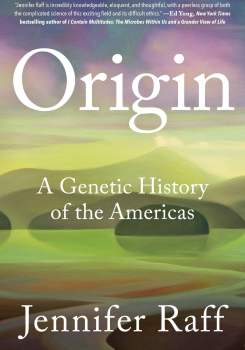How To Extract DNA From A 500 Year-Old Human Tooth
Genetic anthropologist Jennifer Raff walks through the delicate and precise art of obtaining DNA samples from centuries-old human remains.
The following is an excerpt from Origin: A Genetic History of the Americas by Jennifer Raff.
Disclaimer: When you purchase products through the Bookshop.org link on this page, Science Friday may earn a small commission which helps support our journalism.

Origin: A Genetic History of the Americas
It had been a long time since I’d worked at the bench, but as I began the process of decontaminating the surface of the 500-year-old tooth—a soak in bleach, a rinse with DNA-free water, a 10-minute session in the small ultraviolet light box on the benchtop—I was relieved to find I still had my “hands.” Anti-contamination laboratory practices in the ancient lab are exacting, but I have found that they also translated into excellent preparation for a coronavirus pandemic. You must never touch your face with your hands. You must never pass your hands over open tubes, nor leave tubes or containers with their lids off a moment longer than necessary. Every time you touch your hands to any surface, you must bleach them afterward. Every time you finish working in a laboratory space, you must bleach both the benchtop and the equipment you used. It takes a constant mindfulness and hours of training to operate in this environment. Laboratory researchers call anyone who is skilled at working at the bench a person with “good hands.” In the ancient DNA world, this is mostly focused on someone who can maintain this mindfulness in preventing contamination.
This obsessive attention to sterile technique is only one reason why few people want to work in our field. Another reason is how seldom you succeed in actually getting DNA from a bone. While you can obtain huge quantities of DNA from just a swab of a living person’s cheek, ancient DNA is a completely different story. Damaged, fragmented, scarce, and mixed with huge quantities of contaminating modern DNA, the molecules are rarely ever present in detectable quantities within any given bone or tooth, and the process of recovering them is extraordinarily difficult.
My confidence in my hands grew as I moved the cleaned, dried tooth to a large cabinet on a nearby bench. This hood, made of clear plexiglass with a hinged front that opened just enough for me to slip my hands into, was effectively an ancient DNA lab-within-a-lab. We had several of them scattered throughout the room, each dedicated to a few stages of the DNA extraction process. Segregating our activities to different enclosed spaces provides yet another critical measure of protection against contamination. But there was even more care that needed to be taken with the first step of the extraction process; mechanically powdering the bone or tooth sample could result in material getting all over the lab. This meant I would need to operate inside an even smaller space within the hood: to be specific, a small plastic glove box that would catch any loose powder. I snaked a drill through one of the ports on the side and began to carefully work on the tooth. The surface material of the tooth went into a small plastic tray, to be discarded as likely contaminated. I widened the hole I was drilling and scraped powder from the inside of the tooth into a second tray (previously decontaminated by exposure to ultra-violet radiation). Taking the tray out of the box, I weighed it on a scale: 0.025 grams—about half the amount of material that I needed. I continued to drill into the tooth, trying hard not to crack it as I excavated powder. This was my least favorite step in the whole process—I was tense and utterly focused until I had tipped the white powder into a DNA-free plastic tube.
I breathed a sigh of relief when at last I had extracted sufficient powder to move forward. We try not to sample more of an individual’s remains than is absolutely necessary for obtaining DNA, and there is tremendous pressure not to ruin the tiny samples.
But the rewards are worth the pressure.
It’s amazing when you stop to think about it: This tiny extraction from a 500-year-old tooth, this powder, smaller than a pinch of salt, might contain a record of thousands of years of this person’s ancestors. I filled the tube with a solution that contained a chemical to sequester the calcium present in the powder and then added a small amount of an enzyme that would chew up all the proteins present in the sample. I added the same chemicals to a second tube, which would serve as my negative control: a test of whether any DNA was introduced at any of the subsequent stages of the extraction process. If, at the end of the four-day process, DNA turned up in my negative control, I would have to assume that the sample was contaminated as well. I’d then have to evaluate every possible source of contamination—the chemicals, the tubes, the equipment, the benchtop, the water, my own techniques—until I identified the problem and fixed it. Ancient DNA research groups are built upon trust: trust between the descendant communities and the PIs (Principle Investigator), trust between the PIs and their university administrators, trust between the PIs and the students, trust that one’s fellow researchers have good hands, trust that the reagents are DNA-free, and trust that every person will report contamination immediately and do whatever it takes to mitigate it.
Excerpted from Origin: A Genetic History of the Americas ©2022 Jennifer Raff and reprinted by permission from Twelve Books/Hachette Book Group
Jennifer Raff is a genetic anthropologist and an assistant professor at the University of Kansas in Lawrence, Kansas. and author of Origin: A Genetic History of the Americas.